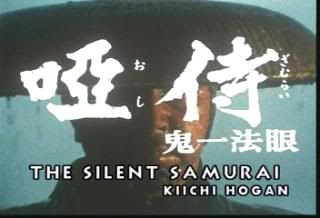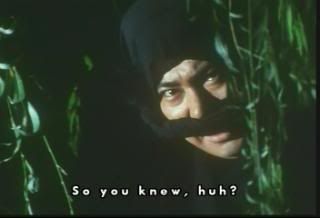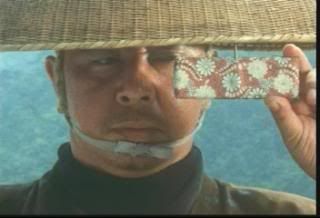
Kiichi Hogan has a reason to be angry: as a young man, an expert fencer named Gonzales slaughtered his family and slit his throat, leaving him mute. 18 years later, Hogan (Wakayama Tomisaburo) is a bounty hunter, searching all over Japan for the devilish Spaniard. It’s a pretty standard, yet classic set up for a revenge story, one that has the potential for an interesting and varied tale.
Outside of a few Kurosawa features, the most popular samurai (or, more specifically, chambara) films in the West certainly seem to be either the Lone Wolf and Cub or Zatoichi film series. The former stars Wakayama, while the majority of the films in the series are directed by Kenji Misumi; the latter stars Shintaro Katsu (Wakayama’s brother), one of Japan’s biggest names. So, fans of samurai films should be delighted to learn that Misumi, Wakayama, and Katsu (along with genre director Hideo Gosha) are all involved in Mute Samurai in one way or another.

The first episode of the series, “The Man Who Lost His Ability To Sing,” introduces the character of Hogan, our hero for the duration. There’s a notable early appearance by Katsu--who also directs--but most of the episode is dominated by Wakayama. We learn about Hogan’s past, and it isn’t long before he’s fallen in with a bad crowd, led by a rogue Catholic priest. The priest thinks he can use Hogan’s sword skills, and lets the bounty hunter in on his drug-trafficking conspiracy. Bad idea. The virtuous Hogan wants none of it. We get to see a display of Wakayama’s familiar and excellent swordplay when Hogan manages to kill every last one of those evil doers.
Episode two, “A Silent Prayer For a Little Boy,” properly introduces the character of ‘Manji,’ played by Katsu in larger, more fleshed-out performance. Manji (the word for the Buddhist swastika) is a mysterious warrior on the side of justice, and that, combined with the fact that it’s Zatoichi himself, should make the character pretty cool. Unfortunately, they put this on him:

“A Silent Prayer For a Little Boy” finds Hogan confronting some foreigners head-on. These Spaniards are up to no good, and Hogan hopes he can find Gonzales among them. Unfortunately, the nefarious fencer is long gone, though Hogan is able to do some good. Some of the local police are involved with the evil foreigners, and these traitors get mowed down in an onslaught of Spanish firepower at the end. Hogan survives, and is able to help a little boy who lost his father in the process.
It’s hard to judge Mute Samurai, or any TV show, from its first two episodes. Since I’ve never seen any other Japanese TV shows from the 70s, I don’t really have anything to compare it to. It is similar, in tone, to the Lone Wolf and Cub series, and obviously Wakayama’s presence makes the comparison evident. The violence, of course, isn’t as explosive or bloody as in that film series, since this is meant for television, and the video quality, likewise, is much less vibrant. The thing that sticks out the most about the series, though, is the rear view mirror in Hogan’s hat:

Up until that, the show seems fairly serious. The rear view mirror really throws me for a loop.
What strikes me, in the first two episodes of Mute Samurai, is the show’s anti-foreigner slant. This isn’t just due to the fact that Gonzales, the absent villain of the show, is Spanish--it’s in the fact that the villain of the first episode is a Catholic priest, and in the focus on the guns that are used to shoot down the samurai at the end of episode two. A nostalgic or even protectionist point of view is fairly common in the samurai genre, but in these early episodes Mute Samurai seems to be hinting at some outright jingoism. Still, time and distance take the edge off of it, making it seem quaint or campy.
Since Mute Samurai doesn’t have an official release in North America, it’s up to the hard core samurai fans to track it down. If the names Wakayama, Katsu, Misumi, and Gosha mean anything to you (and they should!) then you’re going to want to track this down, if only for curiosity’s sake. I found it a bit of a let-down in the action department, but I think as the series finds its footing there’s the potential to do better.










5 comments:
How cinematic is the show? And is there much swordplay in the first couple of episodes?
There's a good deal of swordplay. I was expecting more, I think, but there's definitely more action than your average show.
As to how "cinematic" it is...the dull colors and fullscreen format make that hard to judge, at least for me. I would say that the directing of the first episode, courtesy of Katsu, seems pretty bland, except for maybe the theatrical flashback sequence, but that the second episode gets better in that regard. I think I'll try to catch episode three, which is directed by Misumi, and see what he can do with the medium.
I think this actually opens up an interesting argument about how "important" the exploitative elements (and violence) of the 70s Samurai movies were to their success. It was certainly one of the things that drew me to the Lone Wolf & Cub films.
Then again, the violence in the Zaitoichi films is generally quite muted. And those films always seemed like installments of a series in some ways (which is likely why it was able to translate into a series so easily).
It looks to be shot on film, at least. Would that be correct? And, here's a silly question.. is this a legitimately released DVD or a homebrew?
Well, as I mentioned, there's no NA release, and probably no British one either. Pretty sure the original supplier is SamuraiDVD, which is a pretty reputable (perhaps THE pretty reputable) subberr. And yeah, I'd say it's shot on film.
Your mention of the "exploitative elements" and violence of 70s samurai films makes me rethink the comparison to LW&C--but only briefly. Both have Wakayama as an assassin (he's a pretty lethal bounty hunter in this), both usually have sword fights in ravines, etc., but Mute Samurai is really lacking in sex. It's also (aside from the rear view mirror) drier in tone...at least so far.
On annoying thing is that, at least in ep. 2, Hogan had to converse a lot. What with him being mute, he has to sign or write a lot, etc., and after a while I was thinking that the whole point of him being mute should be a lack of communication.
Supposedly Gosha had The Great Silence in mind when he wrote the original story. Also, Wakayama was supposedly a big fan of spaghetti westerns and Clint Eastwood. I've heard that the show gets more Western-y as it goes.
This sounds cool as all hell. I will have to try to track it down.
Post a Comment